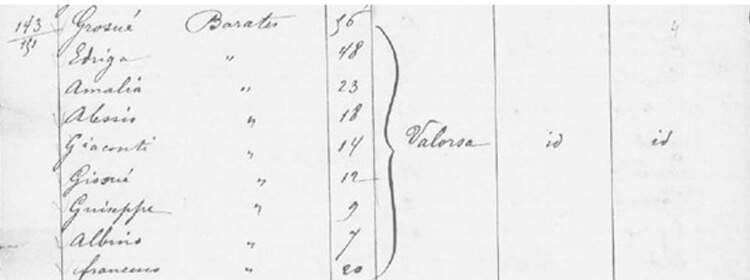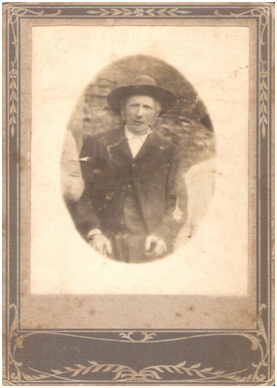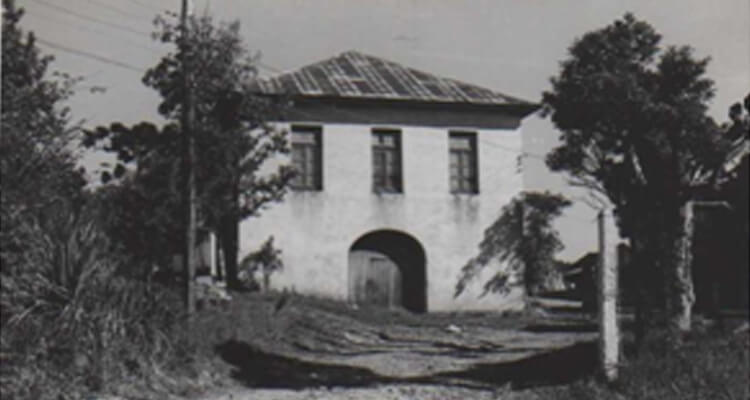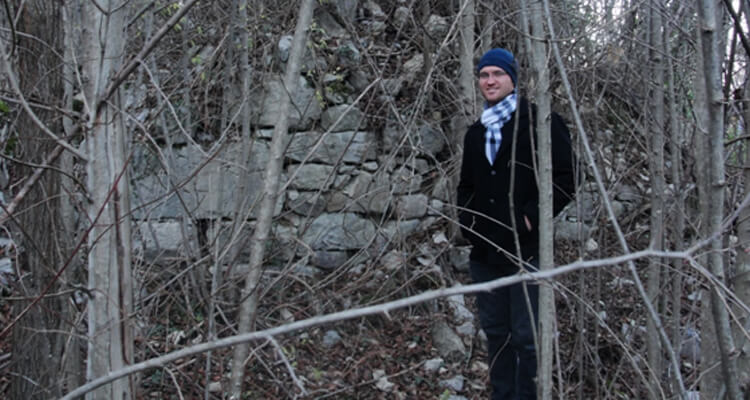Italiani nel Mondo
Emigrazione ieri: Brasile – Migration yesterday: Brazil

Emigrazione ieri: Brasile
Molti in Italia non si rendono conto che anche dopo generazioni, persino in chi non parla più l’italiano oppure un dialetto, nasce la voglia e la volontà di voler scoprire le proprie origini.
Di Gianni Pezzano
Per la prima volta abbiamo una storia dal Sud America, precisamente dal Brasile. In un certo senso e come dice l’autore, visto l’anno (circa quattro decenni prima che il Sud Tirolo diventasse italiano in seguito alla Grande Guerra), si tratta di emigrazione austriaca, ma leggendo la storia non c’è dubbio che questa emigrazione appartiene a tutte e tre le nazioni, Italia, Austria e il Brasile.
La storia è importante per vari motivi. Il primo perché si tratta di una zona dove spesso non ci si pensa quando trattiamo l’emigrazione e dal nord del paese invece del sud che molti pensano sia l’unica fonte principale delle ondate d’emigrazione italiana.
Il secondo motivo è nelle immagini che l’autore ha fornito per illustrare, in tutti i sensi, la Storia della propria famiglia. Per di più, di immagini e documenti che risalgono a oltre 140 anni fa. In questo da una lezione importante a molti di custodire i documenti dei nonni e i bisnonni perché sono parte essenziale della loro storia personale e anche per poter eventualmente permettere alle future generazioni di poter rintracciare le origini .
Ma il terzo motivo è indubbiamente quello che colpisce di più mentre leggiamo questa storia/Storia. Il grande amore dell’autore per la sua famiglia e l’orgoglio altrettanto grande per le proprie origini dopo qualche generazione. Questa è una lezione importante perché molti in Italia non si rendono conto che anche dopo generazioni, persino in chi non parla più l’italiano oppure un dialetto, nasce la voglia e la volontà di voler scoprire le proprie origini.
Infine, abbiamo deciso di mantenere l’italiano dell’autore con pochi cambi perché fornisce un buon esempio della lingua italiana parlata all’estero. Questi cambiamenti sono inevitabili all’estero e documentare queste variazioni della nostra lingua nazionale dovrebbe fare parte del nostro progetto di raccogliere queste storie dell’emigrazione italiana.
Senza dubbio questa storia ci fornisce un esempio importante del potere del richiamo delle origini e dell’orgoglio verso la propria famiglia.
Ora aspettiamo le prossime storie e speriamo che questo esempio darà una spinta importante, sia in Brasile e i paesi sudamericani, sia in tutti gli altri paesi dove si trovano emigrati italiani e i loro discendenti.
Inviate le vostre storie a: redazione@thedailycases.com
Baratter Family – Vallarsa (Südtirol)
By Gustavo Baratieri (Baratter), Iribaiaras, Brazil
Dal Brasile vi scrive un discendente di tirolesi della Vallarsa. Si, è cosi che manteniamo le nostre radici in Brasile. “Semotirolès” – è da un chiacchere fra la mia nonna ed il mio bisnonno Barater che viene questa testimonianza antica della mia famiglia ed è con orgoglio che la porto avanti. Lo “Slambròt” era il dialeto che parlavano “i vèciBarater” nel loro arrivo in Brasile. Slambrot, per chi non è familiarizzato è una sorta di tedesco, odierno “cimbro”. Anche con orgoglio dico: siamo vallarseri, della frazione di Albarè/Albaredo– non perchè nati ad Albaredo –ma perchè il nostro sangue ed il sudore dei nostri antenati ci rimonta a quello posto per almeno quattrocento anni prima della emigrazione della famiglia in Brasile. Ed è stato li che hanno imparato il lavoro con legno – mezzo di sopravvivenza in Brasile. Mai saprò come spiegare l’emozione che ho vissuto quando sono stato nella Vallarsa per la prima volta nell’anno 2013. Questo sarebbe il Desiderio ed i sogni dei miei antenati che non hanno mai avuto l’opportunità di conoscerla. Una voglia di piangere senza controllo, come se io avessi vissuto li per una vita e sapevo ogni difficoltà degli altri tempi. Nella seconda volta sono andato per capire come era la loro vita ed ho scoperto anche il posto dove vivevano, dove lavoravano – e che forse per coloro che sono nati in nel Terriotorio, a volte non valutano quanto merita.
I Baratter, prima del 1667, erano conosciuti come quegli D’Albarè. Tanti altricognomi della valle sono oriundi di nomi di località. Solamente nel 1667 che Thomas figlio di Zua D’Albarè riceve il cognome Baratter per la prima volta quando abitavano alle Porte (Trambileno). E nella mia linea genealogica la prima volta viene nel 1671 con la nascita di Antonio figlio di Thomas Barater D’Albarè e Margarita Thomeson. La frazione di Albaredo, già in quello tempo faceva parte della communità di Vallarsa – ma della Parrochia di Lizzana. Questo è il primo mappa che fa menzione ad Albarè.
 (WarmundYgl, Carta del Tirolo, 1604-1605).
(WarmundYgl, Carta del Tirolo, 1604-1605).
E’ molto importante dire che se oggi parliamo di Vallarsa come parte del territorio del Trentino in Italia, in quel tempo i miei antenati parlavano diSudtirolo/Tirolo italiano e di Austria. Cioè, si tratta di un’emigrazione austriaca. Quegli che emigrarono in Brasile erano austriachi e tirolesi – e tantissimi sono i tirolesi trentini, sopratutto di madrelingua italiana.
Negli ultimi anni della loro vita nella Vallarsa, sono vissuti nel “MasodellaCasetta, sotto Albaredo”, frazione di Sich di Vallarsa e le rovine della casa del mio Giosuè sono ancora presenti. Ho trovato la casa con l’aiuto di un boscaiolo, l’amico Saverio Zendri. I miei antenati sono emigrati nel 1876. Giosuè Cristano Colombano (figlio di Luigi Alessio Barater e Teresa Rumer Sannicolò, della Parrocchia di Terragnolo), si è sposato con Edvige Luigia Gasperini (figlia di Gasparo Gasperini e Lucia Matassoni) nell’anno 1852, nella chiesa di Albaredo. Emigrarono assieme ai suoi 7 figli. Giacinto, uno di loro, fu morto nel mare.
Pochi sono gli emigrati dellaVallarsa in Brasile.Quindi, il dialeto tedesco che era già praticamente scomparso nella própria Vallarsa, non è portato avanti. Ne ho visto alcune famiglie della Vallarsa in Brasile (Barater/Baratieri, Dalzocchio, Martini,Angheben, Stoffela, Nave, Pezzatto). La maggioranza dei vallarserie anche dei Baratter emigrati all’estero si sono spostati in Francia, Germania e Stati Uniti.
Nel sud del Brasile, dove viviamo adesso(dove si trova la zona industriale) e anche la zona più fredda di Brasile, tantissime persone già hanno sentitoparlare sulla valle di Terragnolo e sullaVallagarina, ma nessuno della Vallarsa. Nel loro arrivo in Brasile sono vissuti in un posto chiamato “Linea Leopoldina” che adesso si chiama “Vale dos Vinhedos” situato nel comune di Bento Gonçalves – Rio Grande do Sul (questo comune è gemellato con Trambileno, Terragnolo e Rovereto).
Lista del Bastimento Salier. Uscita: Bremen, nel 25/11/1876. Destino: Rio de Janeiro, Brasile.
 Traduzione: Francesco Barater, nato in Vallarsa, Tirolo, Austria.
Traduzione: Francesco Barater, nato in Vallarsa, Tirolo, Austria.
 Francesco Antonio Barater, nato in Vallarsa – 13/06/1856, figlio di Giosuè Cristano Colombano Barater e di Edvige Luigia Gasperini.
Francesco Antonio Barater, nato in Vallarsa – 13/06/1856, figlio di Giosuè Cristano Colombano Barater e di Edvige Luigia Gasperini.
 Casa di Giosuè Barater in Brasile. (In questa casa, adesso, c’è una vinicola – della famiglia Titton). Bento Gonçalves, Linha Leopoldina, Rio Grande do Sul, Brasile.
Casa di Giosuè Barater in Brasile. (In questa casa, adesso, c’è una vinicola – della famiglia Titton). Bento Gonçalves, Linha Leopoldina, Rio Grande do Sul, Brasile.
 Gustavo Barater – Le rovine della Casa di Giosuè Barater (Emigrato in Brasile nel 1876). MasodellaCasetta – Sich di Vallarsa (sottoAlbaredo).
Gustavo Barater – Le rovine della Casa di Giosuè Barater (Emigrato in Brasile nel 1876). MasodellaCasetta – Sich di Vallarsa (sottoAlbaredo).
 Le rovine della Casa di Giosué Cristano Colombano Barater, a Sich di Vallarsa.
Le rovine della Casa di Giosué Cristano Colombano Barater, a Sich di Vallarsa.
Migration yesterday: Brazil
This is an important lesson for many in Italy who do not understand that even after generations, even by those who no longer speak Italian or a dialect, the desire and the will are born in many to retrace their roots.
By Gianni Pezzano
For the first time we have a story from South America, precisely from Brazil. In one sense and as the author states, considering the year (about three decades before the south Tyrol became a part of Italy after the World War 1) we are dealing with Austrian migration. But reading the story there is no doubt that this migration belongs to all three nations, Italy, Austria and Brazil.
This story is important for a number of reasons. The first, because it involves an area in Italy which we often do not think about when we talk about Italian migration; it is in the north of the country instead of the south which many think is the only main source of the waves of Italian migration.
The second reason is in the images which the author supplied to illustrate, in every way, the History of his family. Furthermore, the images and documents go back over 140 years. In this he gives an important lesson to many to keep their parents’ and grandparents’ documents because they are an essential part of their personal history and also in order to allow future generations to retrace their origins.
But the third reason is undoubtedly the one that strikes us most as we read this story/History; the author’s great love for his family and the pride in his origins, which is just as great even after some generations. This is an important lesson for many in Italy who do not understand that even after generations, even by those who no longer speak Italian or a dialect, the desire and the will are born in many to retrace their roots.
Finally, in translating original Italian we have tried to maintain the flavour of the language used by the author because he gives us a good example of the Italian language spoken overseas. These changes are inevitable overseas and recording the variations of Italy’s national language should be a part of our project to gather these stories of Italian migration.
Without a doubt this story gives us an important example of the power to the call of our origins and our pride for our families.
We now await the next stories and we hope that this example will give an important boost in Brazil and the South American countries, as well as all the other countries where there are Italian migrants and their descendants.
Send your stories to: redazione@thedailycases.com
Baratter Family – Vallarsa (Südtirol)
By Gustavo Baratieri (Baratter), Iribaiaras, Brazil
A descendent of the Tyrolese from the Vallarsa is writing you from Brazil. Yes, it is in this way that we maintain our roots in Brazil. “Semotirolès” (We are Tyrolese), this expression is from a chat between my grandmother and my great grandfather Baratter which shows my family’s ancient testimony and we carry it on with pride. The “Slambròt” was the dialect spoken by the “i vèciBarater” (the old Barraters) when they came to Brazil. For those who do not know it, Slambrot was a sort of German, today’s “cimbro” (High Bavarian). And it is also with pride that I say: we are vallarsesi (from the Vallarsa) and from the hamlet of Albarè/Albaredo – not because we were born in Albaredo – but because our blood and the sweat of our forebears go back to that place for at least four hundred years before the family’s migration to Brazil. And it was here that we learned to work with wood – the means of survival in Brazil. I will never know how to explain the emotion I experienced when I was in the Vallarsa for the first time in 2013. That would have been the Desire and the dreams of my ancestors who never had the chance to know it. A longing to cry uncontrollably, as if I had lived there for a lifetime and I knew all the difficulties of the other times. The second time I went to understand what their life was like and I even discovered the place where they lived, where they worked – and that maybe for those who were born in the area, sometimes they do not give it the worth it deserves.
The Barraters, before 1667 they were known as those of Albarè. Many other nicknames from the area come from names of places. Only in 1667 Thomas son of Zua D’Albarè received the surname Baratter for the first time when they lived at the Porte (Trambileno). And in my genealogical line the first time came in 1671 with the birth of Antonio son of Thomas Barater D’Albarè e Margarita Thomeson. Then the hamlet of Albaredo was already a part of the Vallarsa community – but of the Parish of Lizzana. This is the first map which makes mention of Albarè.
 (WarmundYgl, Map of Tyrol, 1604-1605).
(WarmundYgl, Map of Tyrol, 1604-1605).
It is very important to say that if today we speak of Vallarsa as part of the Trentino in Italy, at that time my ancestors spoke of South/Italian Tyrol and of Austria. That is, it was Austrian migration. Those who migrated to Brazil were Austrians and Tyrolese – and very many are Tyrolese from Trento, above all whose mother tongue was Italian.
In the final years of their lives in Vallarsa they lived in “MasodellaCasetta, sotto Albaredo”, a hamlet of Sich di Vallarsa and the remains of the house of my Giosuè are still there. My ancestors migrated in 1876. Giosuè Cristano Colombano (son of Luigi Alessio Barater and Teresa Rumer Sannicolò, of the Parish of Terragnolo), who married Edvige Luigia Gasperini (daughter of Gasparo Gasperini and Lucia Matassoni) in the year 1852, in the church of Albaredo. They migrated together with their 7 children. One of them, Giacinto, died in the sea.
Few are the migrants of Vallarsa in Brazil. Therefore the German dialect which had already practically disappeared in their Vallarsa was not carried on. I saw some families from Vallarsa in Brazil (Barater/Baratieri, Dalzocchio, Martini,Angheben, Stoffela, Nave, Pezzatto). The majority of those from Vallarsa even some Baratter migrants overseas moved to France, Germany and the United States.
In the south of Brazil where we now live (where there is an industrial area) and also the coldest area of Brazil, many people have heard talk of the Terragnolo Valley and the Vallagarina, but nobody of Vallarsa. When they came to Brazil they lived in a place called “Linea Leopoldina” which is now called “Vale dos Vinhedos” (the Valley of the Vineyards) located in the Council area of Bento Gonçalves – Rio Grande do Sul (this Council is a sister cirty of Trambileno, Terragnolo and Rovereto in Italy).
List of the ship Salier. Issued: Bremen, 25/11/1876. Destination: Rio de Janeiro, Brazil.
 Translation: Francesco Barater, born in Vallarsa, Tyrol, Austria.
Translation: Francesco Barater, born in Vallarsa, Tyrol, Austria.
 Francesco AntonioBarater, born in Vallarsa – 13/06/1856, son of Giosuè Cristano Colombano Barater and of Edvige Luigia Gasperini.
Francesco AntonioBarater, born in Vallarsa – 13/06/1856, son of Giosuè Cristano Colombano Barater and of Edvige Luigia Gasperini.
 House of Giosuè Barater in Brazil. (In this house, now, wine is now produced – of the Titton family). Bento Gonçalves, Linha Leopoldina, Rio Grande do Sul, Brazil.
House of Giosuè Barater in Brazil. (In this house, now, wine is now produced – of the Titton family). Bento Gonçalves, Linha Leopoldina, Rio Grande do Sul, Brazil.
 Gustavo Barater – The reamins of the House of Giosuè Barater (Emigrated to Brazil in 1876). MasodellaCasetta – Sich di Vallarsa (sottoAlbaredo).
Gustavo Barater – The reamins of the House of Giosuè Barater (Emigrated to Brazil in 1876). MasodellaCasetta – Sich di Vallarsa (sottoAlbaredo).
 The remains of the house of Giosué Cristano Colombano Barater, at Sich di Vallarsa.
The remains of the house of Giosué Cristano Colombano Barater, at Sich di Vallarsa.













